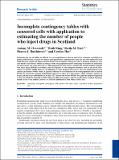Files in this item
Incomplete contingency tables with censored cells with application to estimating the number of people who inject drugs in Scotland
Item metadata
| dc.contributor.author | Overstall, Antony | |
| dc.contributor.author | King, Ruth | |
| dc.contributor.author | Bird, Sheila | |
| dc.contributor.author | Hutchinson, Sharon | |
| dc.contributor.author | Hay, Gordon | |
| dc.date.accessioned | 2014-02-07T15:01:01Z | |
| dc.date.available | 2014-02-07T15:01:01Z | |
| dc.date.issued | 2014-04-30 | |
| dc.identifier | 28450009 | |
| dc.identifier | da9dd546-b5de-4c16-b59a-9902bd16a15c | |
| dc.identifier | 84898056699 | |
| dc.identifier | 000333744000009 | |
| dc.identifier.citation | Overstall , A , King , R , Bird , S , Hutchinson , S & Hay , G 2014 , ' Incomplete contingency tables with censored cells with application to estimating the number of people who inject drugs in Scotland ' , Statistics in Medicine , vol. 33 , no. 9 , pp. 1564-1579 . https://doi.org/10.1002/sim.6047 | en |
| dc.identifier.issn | 0277-6715 | |
| dc.identifier.uri | https://hdl.handle.net/10023/4433 | |
| dc.description.abstract | Estimating the size of hidden or difficult to reach populations is often of interest for economic, sociological or public health reasons. In order to estimate such populations, administrative data lists are often collated to form multi-list cross-counts and displayed in the form of an incomplete contingency table. Log-linear models are typically fitted to such data to obtain an estimate of the total population size by estimating the number of individuals not observed by any of the data-sources. This approach has been taken to estimate the current number of people who inject drugs (PWID) in Scotland, with the Hepatitis C virus (HCV) diagnosis database used as one of the data-sources to identify PWID. However, the HCV diagnosis data-source does not distinguish between current and former PWID, which, if ignored, will lead to over-estimation of the total population size of current PWID. We extend the standard model-fitting approach to allow for a data-source which contains a mixture of target and non-target individuals (i.e. in this case; current and former PWID). We apply the proposed approach to data for PWID in Scotland in 2003, 2006 and 2009 and compare to the results from standard log-linear models. | |
| dc.format.extent | 155534 | |
| dc.format.extent | 252705 | |
| dc.language.iso | eng | |
| dc.relation.ispartof | Statistics in Medicine | en |
| dc.subject | Censoring | en |
| dc.subject | Incomplete contingency table | en |
| dc.subject | People who inject drugs | en |
| dc.subject | Log-linear models | en |
| dc.subject | Population size | en |
| dc.subject | QA Mathematics | en |
| dc.subject | SDG 3 - Good Health and Well-being | en |
| dc.subject.lcc | QA | en |
| dc.title | Incomplete contingency tables with censored cells with application to estimating the number of people who inject drugs in Scotland | en |
| dc.type | Journal article | en |
| dc.contributor.sponsor | Medical Research Council | en |
| dc.contributor.institution | University of St Andrews. School of Mathematics and Statistics | en |
| dc.contributor.institution | University of St Andrews. Scottish Oceans Institute | en |
| dc.contributor.institution | University of St Andrews. Centre for Research into Ecological & Environmental Modelling | en |
| dc.identifier.doi | https://doi.org/10.1002/sim.6047 | |
| dc.description.status | Peer reviewed | en |
| dc.identifier.grantnumber | PO: MCZ907778 | en |
This item appears in the following Collection(s)
Items in the St Andrews Research Repository are protected by copyright, with all rights reserved, unless otherwise indicated.


